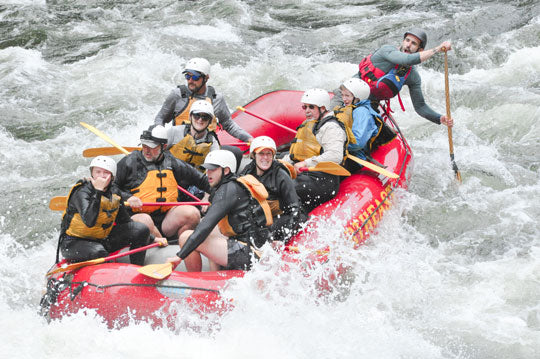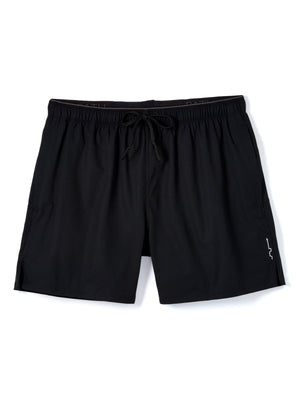Guest post by KREW member Brandon Chase.
This past summer, I returned to my home state of Maine after spending the winter in Mexico and decided that I wanted to spend the majority of my days outside. Though I was already doing some writing and instruction for various outdoor companies and outfitters, I wanted to immerse myself in the outdoor industry and get some more hands-on experience - which led me to whitewater rafting.

Photo by Northeast Whitewater.
Becoming a whitewater raft guide is relatively simple: you need a license (explained below) and affiliation with an outfitter, which is not difficult to come by as there is a lot of customer demand so companies are often hiring guides. Having just finished up my season, I can attest to the fact that this is a fantastic seasonal gig.
Becoming a Whitewater Raft Guide
The process to become a whitewater raft guide varies from state to state, and Maine has some of the most stringent licensing guidelines in the country. The process for obtaining a whitewater license (Level I) in Maine is as follows (abbreviated for clarity):
- Obtain a First Aid/CPR certification.
- Complete a training course with a qualified commercial outfitter of at least 7 days in length.
- Conduct at least twenty training runs on the rivers identified as ''rapidly flowing'', which for our group meant the Kennebec and Penobscot Rivers.
- Complete a minimum of five guided runs on the Kennebec River.
- Pass a written examination given by the Maine Department of Inland Fisheries and Wildlife on topics of whitewater law, ethics, rules, hydrology, geography, river safety, and more.
To achieve a Level II license (necessary to guide on Class V rapids such as those on the Penobscot River), one must possess a Class I license and make ten training runs on the Penobscot River with an additional five guided runs on the Class V section as well as no fewer than six commercial trips with a Class I license.

Who's ready to hit the river? Photo by Northeast Whitewater.
Training to become a whitewater raft guide
I chose to do my training with Northeast Whitewater, a small but well-established outfitter located near Moosehead Lake in Greenville, Maine. The training spanned 10 days in early June and was both immersive and ambitious. Here's the typical schedule:
- 4:30am: Wake up, get dressed - e.g. put on your cold and still-wet-from-yesterday wetsuit
- 5:00am: Meet with training group to arrange boats on the trailer in preparation for the day's river runs. We all camped at base for training so the commute was short.
- 6:00am: Drive to river.
- 7:00am - 4pm: River runs, up to 4 per day. Practicing guide strokes, safety procedures, river geography. Eat lunch on drive between runs.
- 4pm - 7pm: Deflate boats, load onto trailer, drive back to base, unload boats, perform maintenance and put away gear.
- 7pm-7:30pm: Dinner break.
- 7:30pm - 10:30pm: Classroom work to review regulations, hydrology, rules, ethics, and geography and practice skills.
- 10:30pm-11pm: Bed.
Training is akin to bootcamp in many ways: they want you to think about rafting and nothing else for that time period, and there is a lot of material and skills that the instructors need to teach in a short amount of time so the days are long and the work is hard. Each raft weighs 250lbs or more and you spend a lot of time moving, inflating, deflating, rolling, and transporting them. What's more, you need to learn all of the laws and regulations in order to pass the exam, not to mention the geography of the river so you know which features to hit and which to avoid. By the end of the training you will be mentally and physically exhausted.

My training class after we completed our last runs of the course. Ready for a nap!
One the final day of training, the Game Warden comes to proctor the license exam. It has 100 multiple-choice questions covering all the material you have jammed into your brain over the preceding ten days. If you pass, and everyone from my class of nine did, you will receive your Level I license on the spot (after paying the $189 fee, of course) and be a Registered Maine Guide. This allows you to guide commercial whitewater raft trips if affiliated with an outfitter, as you cannot do them on your own.

Freshly minted Maine Guide!
Day to Day of a whitewater raft guide
Once your training and licensure is complete, you can begin guiding commercial trips immediately. Once I started, I was on the river anywhere between two to four times per week while alternating with guided moose and nature tours on off days.

Hold on to yer butts! Photo by Northeast Whitewater.
The day-to-day work of a guide isn't all that different from training, although it's a bit less strenuous and more familiar. Here's the typical schedule for a commercial rafting trip:
- 6:45am: All guides meet at base to discuss the day's trip and divide morning responsibilities
- 7:00am: Break off to do your morning duties. You're either in the kitchen preparing the river lunch or outside cleaning the bathrooms and preparing life jackets, helmets, and paddles for customers.
- 8:45am: Customers begin to arrive and check in.
- 8:45am - 9:45am: Get everyone checked in and fitted for wet suits (if desired), life jackets, helmets, and paddles. Introduce them to their guide, take a photo, and load onto the bus.
- 10:30am: Arrive at the dam. Give a safety speech to your crew, walk the boats down to the river and put-in.
- 10:45am - 2pm: Rafting!
- 2pm-3:30pm: Lunch on the bank of the river prepared by the guides
- 4:30pm: Arrive back at base
- 4:30-7pm: Clean up from the trip - dry and put away wetsuits and life jackets, store paddles and helmets, prepare boats on trailer for the next day, clean up lunch dishes and coolers.
- 7pm-7:15pm: Guide's meeting to discuss how the day went
- 7:30pm: Head home.
Much like training, the days are long. You only spend a little over 3 hours on the river with your clients and the rest of the time is preparation and cleanup. If it's an especially small trip you may end up finishing an hour or two early, but more often than not you're putting in a 12+ hour day from start to finish.
Dangers of whitewater rafting
I'm often asked how dangerous it is to go whitewater rafting, usually by nervous first-timers. While serious injuries are exceedingly rare, it's not uncommon for people to fall out of the raft or for it to flip over if you hit a wave at the wrong angle (which can be caused by guide error, a change in the river hydraulics, or customers not paddling when they are supposed to). When this happens, nine times out of ten they pop up right next to the raft and we pull them in right away. Sometimes, they end up swimming through the rapid which can be rough if you swallow a lot of water. Although everyone wears a lifejacket at all times and they are buoyant enough to keep you afloat, you can still have a bad time with a harsh swim.
During our training we flipped the raft several times on purpose so we would understand what it felt like to swim the rapids, and it certainly gives you a healthy respect for the water. I only had a couple of people fall out of my boat all season and I never flipped, though I didn't run the Class V rapids since I only have a Class I license. Rafting is not something to be scared of, but you do need to keep your wits about you when on the river with clients.

Are you not entertained?! Photo by Northeast Whitewater.
Earning Potential of a Whitewater Guide
Being a whitewater raft guide is not something one does to get rich - it's a lifestyle choice. Most guides will raft in the summer and work other seasonal jobs in the winter (usually ski resorts) to make ends meet and generally live a low-cost and simple, aka ''dirtbag'', lifestyle. Many outfitters allow for guides to camp at their base for the season, eliminating a large chunk of their living costs. I was, by a fair amount, the oldest raft guide in my training class and at the outfitter at 34 years old - most were just out of high school or between college semesters so their costs tend to be much lower.
Nevertheless, guides are paid a wage in addition to receiving tips from customers. The pay rate is generally between $12-$16 per hour depending on experience and tips can range between $0 (ouch) and $200 with an average of $80-$100 per trip.
The major non-monetary benefits of becoming a guide are that you get to spend every day outside with people who are (usually) excited and ready to have a great time while also building skills and a reputation in the industry. And, of course, you get to go rafting more often in a week than most people will do in their entire lives!

Another group of happy customers! Photo by Northeast Whitewater.
PATH Gear used
Though typically associated with on-land pursuits, I found that my Path Projects gear worked extremely well for river trips as well. Here’s what I loved to wear this summer:
- Big Bend 2 Trucker Cap - For everyday wear around town and, most importantly, on the lower and calmer sections of the river when helmets are not required, this cap kept my head cool and the sun off my face.
- Cascade SS & LS shirt: For morning duties and prep work or around base, this was my go-to top.
- Graves PX shorts: I wore these on every single trip down the river. Having the zippered hand pockets for extra storage was clutch, and the stretchable, quick-dry fabric meant I was comfortable all day.
- Tahoe CL Full Length Base Liner: I wore these under my wetsuit in the early season and under my Graves PX shorts for summer trips and my morning commute to and from the base. They are incredibly comfortable and kept me super warm when the river water was at its coldest.
- Wheeler FT short: on off days or around town, I lived in these shorts. Love them!
Wrap-up
Being a whitewater raft guide in Maine was a ton of fun and a very rewarding experience. Though there are some hurdles to get through in regards to training and licensure, it's something you can start at the beginning of the season with very little experience and learn as you go. The work is hard but it’s a great way to build skills, be outside, and have fun!
--
Find out more about Brandon Chase on his KREW bio page, his Strava and Instagram.







1 comment
Full expired